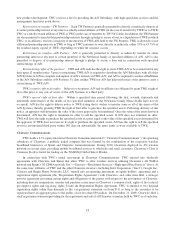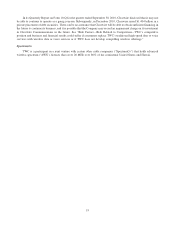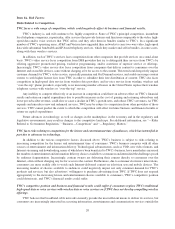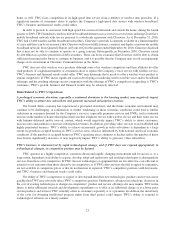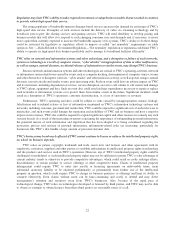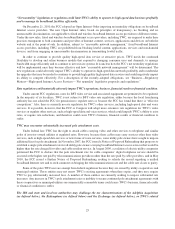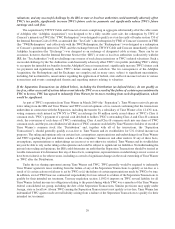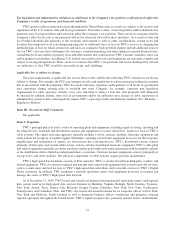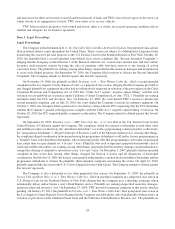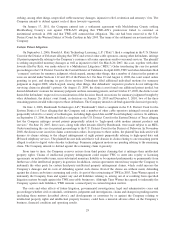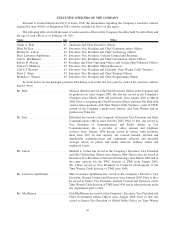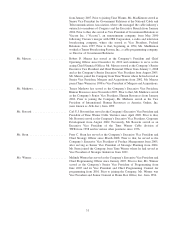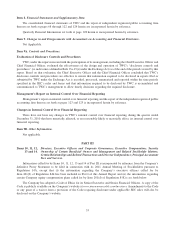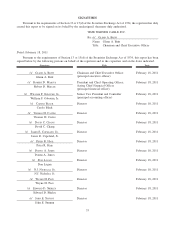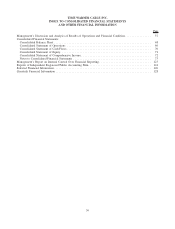Time Warner Cable 2010 Annual Report Download - page 39
Download and view the complete annual report
Please find page 39 of the 2010 Time Warner Cable annual report below. You can navigate through the pages in the report by either clicking on the pages listed below, or by using the keyword search tool below to find specific information within the annual report.Tax legislation and administrative initiatives or challenges to the Company’s tax positions could adversely affect the
Company’s results of operations and financial condition.
TWC operates cable systems in locations throughout the United States and, as a result, it is subject to the tax laws and
regulations of the U.S. federal, state and local governments. From time to time, various legislative and/or administrative
initiatives may be proposed that could adversely affect the Company’s tax positions. There can be no assurance that the
Company’s effective tax rate or tax payments will not be adversely affected by these initiatives. As a result of state and
local budget shortfalls due primarily to the economic environment as well as other considerations, certain states and
localities have imposed or are considering imposing new or additional taxes or fees on TWC’s services or changing the
methodologies or base on which certain fees and taxes are computed. Such potential changes include additional taxes or
fees on TWC’s services that could impact its customers, combined reporting and other changes to general business taxes,
central/unit-level assessment of property taxes and other matters that could increase TWC’s income, franchise, sales, use
and/or property tax liabilities. In addition, U.S. federal, state and local tax laws and regulations are extremely complex and
subject to varying interpretations. There can be no assurance that TWC ’s tax positions will not be challenged by relevant
tax authorities or that TWC would be successful in any such challenge.
Applicable law is subject to change.
The exact requirements of applicable law are not always clear, and the rules affecting TWC’s businesses are always
subject to change. For example, the FCC may interpret its rules and regulations in enforcement proceedings in a manner
that is inconsistent with the judgments TWC has made. Likewise, regulators and legislators at all levels of government
may sometimes change existing rules or establish new rules. Congress, for example, considers new legislative
requirements for cable operators virtually every year, and there is always a risk that such proposals will ultimately
be enacted. In addition, federal, state or local governments and/or tax authorities may change tax laws, regulations or
administrative practices that could negatively impact TWC’s operating results and financial condition. See “Business—
Regulatory Matters.”
Item 1B. Unresolved Staff Comments.
Not applicable.
Item 2. Properties.
TWC’s principal physical assets consist of operating plant and equipment, including signal receiving, encoding and
decoding devices, headends and distribution systems and equipment at or near subscribers’ homes for each of TWC’s
cable systems. The signal receiving apparatus typically includes a tower, antenna, ancillary electronic equipment and
earth stations for reception of satellite signals. Headends, consisting of electronic equipment necessary for the reception,
amplification and modulation of signals, are located near the receiving devices. TWC’s distribution system consists
primarily of fiber optic and coaxial cables, lasers, routers, switches and related electronic equipment. TWC’s cable plant
and related equipment generally are either attached to utility poles under pole rental agreements with local public utilities
or the distribution cable is buried in underground ducts or trenches. Customer premise equipment consists principally of
set-top boxes and cable modems. The physical components of cable systems require periodic maintenance.
TWC’s high-speed data backbone consists of fiber owned by TWC or circuits leased from third-party vendors, and
related equipment. TWC also operates regional and national data centers with equipment that is used to provide services,
such as e-mail, news and web services to TWC’s high-speed data subscribers and to provide services to TWC’s Digital
Phone customers. In addition, TWC maintains a network operations center with equipment necessary to monitor and
manage the status of TWC’s high-speed data network.
As of December 31, 2010, TWC leased and owned real property housing national operations centers and regional
data centers used in its high-speed data services business in Herndon, Virginia; Raleigh, North Carolina; Syracuse,
New York; Austin, Texas; Kansas City, Missouri; Orange County, California; New York, New York; Coudersport,
Pennsylvania; and Columbus, Ohio, and TWC also leased and owned locations for its corporate offices in New York,
New York and Charlotte, North Carolina as well as numerous business offices, warehouses and properties housing
regional operations throughout the United States. TWC’s signal reception sites, primarily antenna towers and headends,
27



